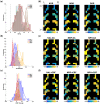Brain opioid segments and striatal patterns of dopamine release induced by naloxone and morphine
- PMID: 34873784
- PMCID: PMC8837588
- DOI: 10.1002/hbm.25733
Brain opioid segments and striatal patterns of dopamine release induced by naloxone and morphine
Abstract
Opioid receptors are expressed throughout the brain and play a major role in regulating striatal dopamine (DA) release. Clinical studies have shown that naloxone (NAL, a nonspecific opioid antagonist) in individuals with opioid use disorder and morphine (MRP, a nonspecific opioid agonist) in healthy controls, resulted in DA release in the dorsal and ventral striatum, respectively. It is not known whether the underlying patterns of striatal DA release are associated with the striatal distribution of opioid receptors. We leveraged previously published PET datasets (collected in independent cohorts) to study the brain-wide distribution of opioid receptors and to compare striatal opioid receptor availability with striatal DA release patterns. We identified three major gray matter segments based on availability maps of DA and opioid receptors: striatum, and primary and secondary opioid segments with high and intermediate opioid receptor availability, respectively. Patterns of DA release induced by NAL and MRP were inversely associated and correlated with kappa (NAL: r(68) = -0.81, MRP: r(68) = 0.54), and mu (NAL: r(68) = -0.62, MRP: r(68) = 0.46) opioid receptor availability. Kappa opioid receptor availability accounted for a unique part of variance in NAL- and MRP-DA release patterns (ΔR2 >0.14, p <.0001). In sum, distributions of opioid receptors distinguished major cortical and subcortical regions. Patterns of NAL- and MRP-induced DA release had inverse associations with striatal opioid receptor availability. Our approach provides a pattern-based characterization of drug-induced DA targets and is relevant for modeling the role of opioid receptors in modulating striatal DA release.
Keywords: dopamine; k-means; morphine; naloxone; opioid receptors; positron emission tomography (PET); striatum.
© 2021 The Authors. Human Brain Mapping published by Wiley Periodicals LLC. This article has been contributed to by US Government employees and their work is in the public domain in the USA.
Conflict of interest statement
The authors declare no potential conflict of interest.
Figures




Similar articles
-
Effect of naloxone on morphine-induced changes in striatal dopamine metabolism and glutamate, ascorbic acid and uric acid release in freely moving rats.Brain Res. 1998 Jun 22;797(1):94-102. doi: 10.1016/s0006-8993(98)00371-0. Brain Res. 1998. PMID: 9630540
-
Effects of selective opioid receptor antagonists on morphine-induced changes in striatal and limbic dopamine metabolism.Pharmacol Toxicol. 1995 Sep;77(3):204-8. doi: 10.1111/j.1600-0773.1995.tb01013.x. Pharmacol Toxicol. 1995. PMID: 8884884
-
Local and distal effects induced by unilateral striatal application of opiates in the absence or in the presence of naloxone on the release of dopamine in both caudate nuclei and substantiae nigrae of the cat.Brain Res. 1983 Jan 10;258(2):229-42. doi: 10.1016/0006-8993(83)91146-0. Brain Res. 1983. PMID: 6824913
-
NMDA and D1 receptors mediate induction of c-fos and junB genes in striatum following morphine administration: implications for studies of memory.Behav Brain Res. 1995 Jan 23;66(1-2):225-30. doi: 10.1016/0166-4328(94)00146-7. Behav Brain Res. 1995. PMID: 7755894 Review.
-
Peptide and nonpeptide ligands for opioid receptors.Acta Pol Pharm. 1995 Sep-Oct;52(5):349-63. Acta Pol Pharm. 1995. PMID: 8960271 Review.
Cited by
-
Single nuclei transcriptomics in human and non-human primate striatum in opioid use disorder.Nat Commun. 2024 Jan 31;15(1):878. doi: 10.1038/s41467-024-45165-7. Nat Commun. 2024. PMID: 38296993 Free PMC article.
-
Oxytocin Reduces Methylphenidate-Induced Dorsal Striatal Dopamine Release in Male Rhesus Macaques.Int J Neuropsychopharmacol. 2024 Dec 28;28(1):pyae056. doi: 10.1093/ijnp/pyae056. Int J Neuropsychopharmacol. 2024. PMID: 39626021 Free PMC article.
-
Glucose metabolism alterations and Aβ deposition in AD and FTD are related to the distribution of neurotransmitter systems.Eur J Nucl Med Mol Imaging. 2025 Aug 7. doi: 10.1007/s00259-025-07485-8. Online ahead of print. Eur J Nucl Med Mol Imaging. 2025. PMID: 40773016
-
Longitudinal and Concurrent Changes in Brain and Gut due to Morphine Self-Administration.Addict Biol. 2025 Jun;30(6):e70059. doi: 10.1111/adb.70059. Addict Biol. 2025. PMID: 40495357 Free PMC article.
-
An autonomic mode of brain activity.Prog Neurobiol. 2023 Oct;229:102510. doi: 10.1016/j.pneurobio.2023.102510. Epub 2023 Jul 27. Prog Neurobiol. 2023. PMID: 37516341 Free PMC article.
References
-
- Bilgel, M. , Beason‐Held, L. , An, Y. , Zhou, Y. , Wong, D. F. , & Resnick, S. M. (2020). Longitudinal evaluation of surrogates of regional cerebral blood flow computed from dynamic amyloid PET imaging. Journal of Cerebral Blood Flow and Metabolism, 40(2), 288–297. 10.1177/0271678x19830537 - DOI - PMC - PubMed
-
- Birn, R. M. , Converse, A. K. , Rajala, A. Z. , Alexander, A. L. , Block, W. F. , McMillan, A. B. , … Populin, L. C. (2019). Changes in endogenous dopamine induced by methylphenidate predict functional connectivity in nonhuman primates. The Journal of Neuroscience, 39(8), 1436–1444. 10.1523/jneurosci.2513-18.2018 - DOI - PMC - PubMed
Publication types
MeSH terms
Substances
Grants and funding
LinkOut - more resources
Full Text Sources
Research Materials

